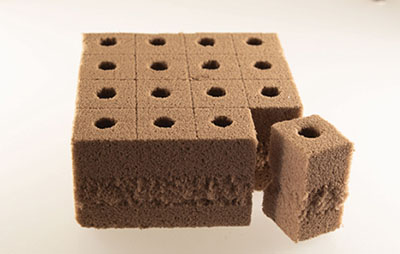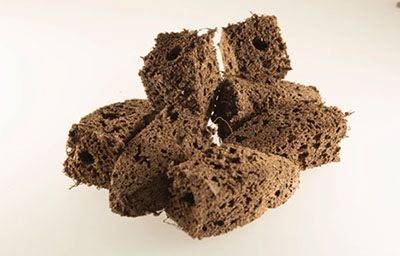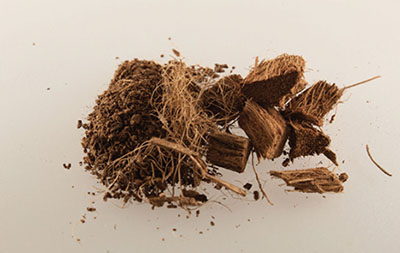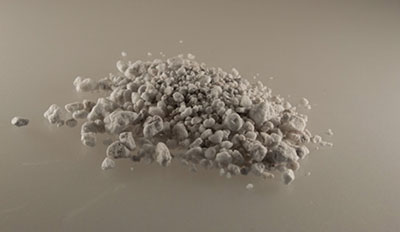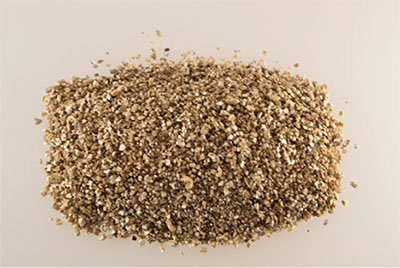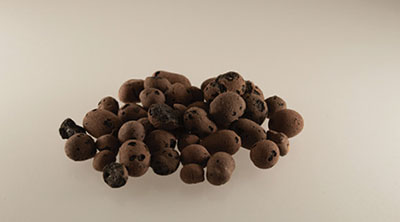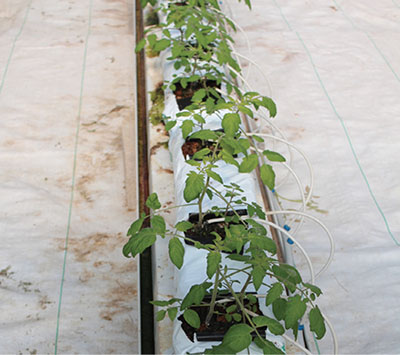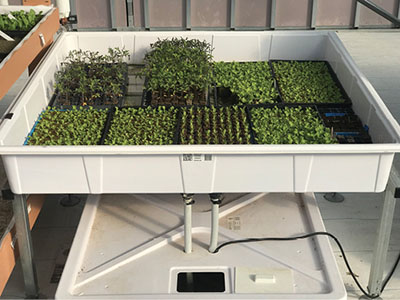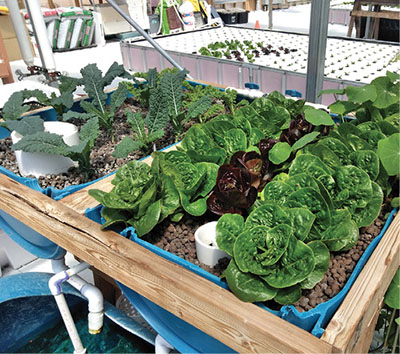Guide H-180
Rossana Sallenave and R. Charlie Shultz
College of Agricultural, Consumer and Environmental Sciences, New Mexico State University
Respectively, Extension Aquatic Ecology Specialist, Department of Extension Animal Sciences and Natural Resources, New Mexico State University; and Lead Faculty at Controlled Environment Agriculture, School of Trades, Technology, Sustainability, and Professional Studies, Santa Fe Community College. (Print Friendly PDF)
Introduction
As freshwater resources become increasingly scarce across New Mexico and arid regions around the world, water-conserving farming techniques, like hydroponics, are being used by crop producers to extend water use while consistently producing high-quality, safe food for local communities. Hydroponics is a form of plant cultivation in which plants are grown without soil by using mineral nutrient solutions dissolved in water. The roots of the plants are bathed in highly oxygenated, nutrient-rich water, with or without the support of an inert medium, such as gravel, perlite, or other substrates. This results in plant growth rates far greater than those found in soil-grown plants. Another advantage hydroponics offers over traditional soil-based plant cultivation is that it can grow crops using substantially less water than soil-based agriculture (Barbosa et al., 2015; Treftz and Omaye, 2015; Verdoliva et al., 2021). This makes hydroponics particularly suited to harsh, arid environments such as New Mexico, where arable land and water are scarce. Due to these water-conserving attributes, hydroponics is presently in use in hot, arid countries, such as Israel and UAE. Here in North America, much of the greenhouse-produced tomatoes, basil, and lettuce are grown using hydroponic techniques.
Most commonly, hydroponic systems are set in a controlled indoor environment like a greenhouse (Figure 1), which greatly reduces their land area requirements and allows them to be located in areas with limited space, such as urban environments. There is also interest from NASA in hydroponics as a means of efficiently producing fresh food on long space missions. In October 2021, a variety of New Mexico chile pepper—NuMex ‘Española Improved’—was grown and harvested in space using a hydroponic system, earning it the title of first fruit ever harvested in space (Acosta, 2021).
Figure 1. Dome greenhouse housing several hydroponic systems (NFT, DWC, and ebb and flow, all described below) (photo courtesy of R. Shultz).
Basic Components of Hydroponic Systems
There are several types of hydroponic systems, but each consists of a basic framework that includes three essential components:
- A nutrient reservoir, which holds water containing nutrients in the correct concentration and balance to be taken up by the plants.
- A distribution system, which is required in circulating systems.
- A plant growth platform, which supports and positions the roots to bathe in the nutrient solution.
The type of system will depend on the needs and overall goals of the producer, ranging from very simple and inexpensive (suitable for backyard and home growers) to complex and more elaborate (used by commercial operations). Depending on the type of hydroponic system, plants are grown with or without the use of artificial media, or substrate. Some systems require an aeration system, while others do not. Regardless of the type of system, it is the nutrient solutions—rather than the media in which the plants are growing—that supply the plants’ nutrient requirements.
Nutrient Solutions
Plant nutrient solutions should include the 16 essential elements that are needed by all plants for growth; these are listed in Table 1. These nutrients are often split into three groups. The first group consists of the three macronutrients that plants can obtain from water, air, or both—carbon (C), hydrogen (H), and oxygen (O)—and are therefore not sold as fertilizers. A grower must supply the other 13 essential elements, which make up the other two groups—macronutrients and micronutrients. This split is based on the actual amount of nutrient required for adequate plant growth. Growers often experiment with or supplement other nutrients that may be beneficial to some plants.
|
Table 1. Nutrients Required for Plant Growth |
|
|
Macronutrients |
Micronutrients |
|
C Carbon* |
Cl Chorine |
|
H Hydrogen* |
Fe Iron |
|
O Oxygen* |
Mn Manganese |
|
N Nitrogen |
B Boron |
|
P Phosphorus |
Zn Zinc |
|
K Potassium |
Cu Copper |
|
Mg Magnesium |
Mo Molybdenum |
|
Ca Calcium |
|
|
S Sulfur |
|
Nutrients are often sold in a pre-blended concentrated form as A and B formulations, each containing a different set of nutrients. These concentrated formulations are kept separate to prevent precipitation that can occur if the different nutrients are mixed together at such high concentrations. If they are added together in a diluted form, the nutrients will stay in solution and be available to the plants. Growers should follow the mixing directions on the product label.
Growers may also choose to create their own nutrient solution by using individual nutrient salts. These fertilizer salts should be water-soluble and of hydroponic-grade nutrients. Growers who want to make their own nutrients or step into commercial hydroponics are recommended to refer to Resh (2013) for complete information.
Growers should always consider the minerals contained in their source water when adjusting nutrient recipes in hydroponic systems. Some minerals like calcium or magnesium may be desired, but others such as sodium would not. For water sources with excessive minerals or contaminants, a pre-filtration or disinfection step may be required. A complete nutrient analysis of your source water can be determined through a certified laboratory, or check with your local Cooperative Extension Service office (https://aces.nmsu.edu/county/) for advice on having your water tested.
After mixing a nutrient solution, growers should adjust the pH and check the total nutrient strength. Most hydroponic crops grow well in the pH range between 5.5 and 6.5. Handheld pH meters are inexpensive, but require calibration and proper storage to ensure accuracy. The fertilizer strength can be measured using a total dissolved solids (ppm) or an electrical conductivity (mS/cm) meter. These meters do not measure individual nutrients, but instead indicate the strength of the total nutrient solution and help a grower manage the fertilizer supply to the crops.
Media
Unlike traditional gardening, plants in hydroponic systems are grown in a soilless, aqueous environment. Hydroponic systems use different types of grow media to act as structural support for the roots and to maintain a ratio of water to oxygen that is vital to the health of the plants. There are many characteristics to consider when choosing a medium. The primary consideration is that the medium be inert, meaning that it will not break down over time. This ensures that the medium will not leach unknown chemicals into the water, changing the nutrient dynamics or pH level of the nutrient solution. Other characteristics a grower may consider include cost, availability, compostability, reusability, weight, water-holding capacity, and porosity. Some of the most popular types of media and their characteristics are listed in Table 2.
Types of media
Many options exist for media with the desired characteristics listed above, and sometimes growers combine media to take advantage of the benefits of each. Some media are ideal for seedling production, while others are more suited for large plant support. Media cubes (or plugs) are often used to start seedlings (Figure 2). These cubes allow for the production of young transplants that can then be placed into existing hydroponic systems with little damage to young roots.
Figure 2. Seed starter plugs and grow cubes made of artificial media are used to propagate seedlings until they are ready to be transferred to their hydroponic system (photo courtesy of R. Shultz).
Types of Hydroponic Systems
Hydroponic systems fall into one of two categories based on the approach used to manage their nutrient systems: open systems and closed systems. Within these two categories, some systems are media-based and some are entirely water-based.
Open systems
In open systems, plants are grown in containers with media and the nutrients are provided through the irrigation system. In open systems, a fresh nutrient solution is added with each irrigation cycle, usually using a drip system. Open systems are flow-through and unidirectional, with excess water and nutrients drained off as waste (leaching). The advantage of open systems is that nutrients are dosed once with each irrigation cycle and no corrections or adjustments are needed. These systems require less infrastructure, are easy to construct, and are less costly. Fertilizer injector systems are commonly used with open hydroponic systems, adding the exact amount of nutrients with each pass of fresh water and limiting the amount of waste water discharged daily. There is also less risk of spreading root-borne diseases. The disadvantages are that irrigation cycles must be carefully managed, these systems waste water and nutrients, and the waste nutrient solution can end up contaminating surface water and/or groundwater.
Bag culture system
One example of an open system is the bag or slab culture system, also known as pillow culture. Plants are grown in commercially prepared or grower-filled bags that contain growing media (Figures 3A and 3B). Common media for bag culture include rockwool, perlite, coconut coir, and biochar. Plants are often started in media cubes and transplanted into 3- to 6-foot slabs. Bags containing media are usually laid flat on the greenhouse floor in paired rows with proper spacing, with the drip irrigation system placed next to the bags between the double rows (Figure 3A). Holes are made in the upper surface of each bag for the transplants, and a few small slits are made low on each side of the bags to prevent flooding of the bags if irrigation is not properly managed. The leachate is collected for disposal or can be reused in other agricultural systems (Figure 3B).
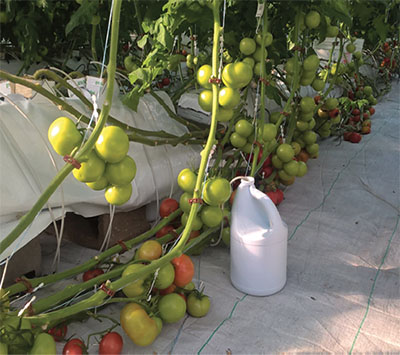
Figures 3A (top) and 3B (bottom). Bag culture systems are typically used to grow fruiting and vining crops (photos courtesy of R. Shultz).
Fruiting and vining crops are most commonly grown in bag culture. Long-term crops like tomatoes can produce well for up to one year. Cucumbers typically produce fruit for 4–5 months. It is possible to produce a second crop in the same bag by adding new transplants about a month before taking out the previous crop.
Closed systems
In closed systems, the nutrient solution is in continuous use and no nutrient wastewater is discharged. Nutrient concentrations are monitored and adjusted regularly depending on the changing needs of the growing plants. Closed systems may be static or recirculating. Recirculating the nutrient solution results in reduced fertilizer costs, immense water savings, and little effluent discharge. Closed hydroponic systems help to protect surface and groundwater quality by minimizing water use and the discharge of fertilizer into the environment (Rosa-Rodríguez et al., 2020). Closed systems range from very simple hydroponic systems to highly sophisticated ones. The following section provides a brief overview of some of these systems.
Closed non-recirculating systems
Non-recirculating wick
Wick systems are an example of a closed system that does not recirculate. They are the most basic form of hydroponics, and are easy to set up and can be made from inexpensive materials. Wicking systems use two or more wicks to deliver water from a reservoir below the plants to the roots via capillary action, always maintaining a moist root zone. Hydroponic wick systems are passive, meaning they work without the need for any pumps, motors, or moving parts.
The Kratky system
The Kratky system is another example of a passive closed hydroponic system that does not recirculate. In this system, plants are supported and suspended above a reservoir of nutrient-rich water, with only the root tips touching the surface of the water (Figure 4). There is no addition of water or nutrients after the initial setup. As the plants grow, they take up the nutrient-rich water, which lowers the water level and creates a gap of air that will expose part of the roots, allowing them to absorb oxygen. By the time the water in the reservoir is fully depleted, the plant is ready for harvest (Kratky, 2009). This simple system is often referred to as “set it and forget it” hydroponics.
Figure 4. The Kratky system is an example of a simple closed non-recirculating system (photo courtesy of R. Shultz).
The advantage of wick and Kratky systems is that they are inexpensive to set up, easy to maintain, and require no electricity to operate. However, these systems are not suitable for commercial-scale production or for high-maintenance or large plants that consume large amounts of water. For this reason, these systems are best suited for growing smaller, fast-growing, non-fruiting plants that require smaller amounts of water, such as lettuce and herbs. They are also good for starting plants that will be grown elsewhere.
Closed recirculating systems
Ebb and flow systems
Ebb and flow, also known as flood and drain, is a widely used hydroponic system. It is considered to be of intermediate difficulty to construct and maintain, is very versatile, and is relatively inexpensive to set up. In this system, plants grown in pots or buckets in a sterile medium are placed in a holding tray, which is periodically flooded with a nutrient solution pumped out of a reservoir below. The water is returned to the reservoir by gravity to be reused.
The holding tray is a large, shallow container on a tall stand, which holds the pots or other type of container in which plants are grown. The reservoir is positioned directly under the stand holding the tray and is connected to the tray by a fill tube and a drain tube. The fill tube attaches to a submersible pump with a timer, which controls the flow of water that floods the tray. The drain tube allows gravity to pull the water back into the reservoir after flooding so that the water can be reused (Figures 5A and 5B).
Figures 5A (top) and 5B (bottom). Examples of ebb and flow systems. A DWC system (explained below) can be seen in the background of Figure 5B (photos courtesy of R. Shultz).
The Dutch bucket (also called Bato bucket) system is a variation of the flood and drain method. The nutrient solution is applied to the surface of the buckets through drip emitters (there is no flood tray), then drains back to the reservoir at regular intervals (Figure 6). Grow media used in bucket culture generally include pea gravel, LECA, perlite, coconut coir, or rockwool.
Figure 6. Dutch bucket systems are an example of the flood and drain method and are often used to grow heavy fruiting plants such as tomatoes (photo courtesy of R. Shultz).
Deep water culture
Deep water culture (DWC), also known as deep flow technique (DFT), floating raft technology (FRT), or raceway culture, is an example of a closed recirculating system that is widely used in both hobby and commercial operations. This method uses a shallow rectangular tank filled with an oxygen-rich nutrient solution on which polystyrene boards (rafts) float. Seedlings are first germinated in seedling trays (Figure 2) and then transplanted into the rafts, which then dangle over the nutrient solutions with the plant roots submerged. The large volume of water contained in the tanks prevents sudden changes in temperature, pH, nutrient strength, and composition. DWC is typically used to grow fast-growing, non-fruiting crops such as leafy greens and herbs (Figure 7), but is also used for fruiting and vining crops. To maintain adequate levels of oxygen in these systems, aeration or circulation of the water will be needed.
Figure 7. A DWC system used to grow basil. Notice the dense rooting system (photo courtesy of R. Shultz).
Nutrient film technique
Nutrient film technique (NFT) is another hydroponic system commonly used in both small-scale and commercial operations. Unlike DWC, which uses large bodies of nutrient water to bathe the roots of suspended plants, NFT systems use very shallow streams of nutrient water that are recirculated past the plant roots in watertight gullies or channels (Figure 8). This ensures that roots are kept moist and nourished but not waterlogged, with the upper portions of the roots remaining dry and oxygenated. In NFT systems, the nutrient solution flows continuously over the roots via gravity, then flows down toward the drainpipe. Water is pumped back up, and new nutrient solution is constantly delivered into the upper end of the channel. NFT systems work best to grow lightweight plants such as leafy greens that do not require a great deal of support, unless support structures such as trellises are used to support heavier plants like tomatoes. Because of their lightweight design, NFT systems are well suited for growing plants on urban rooftop farms.

Figure 8. Example of an NFT system, often used for small-rooted or fast-growing crops (photo courtesy of R. Shultz).
Aeroponics
Aeroponics is another example of a closed recirculating hydroponic system. Like NFT and DWC, no media are used to grow plants after the seedlings (developed in grow plugs) are transferred into the system. Plants are supported in channels, with a nutrient solution periodically delivered through misting of the roots (Figure 9). In addition to growing food crops, aeroponics systems are often used for propagating new plants, or for the production of medicinal root crops. Hobby growers may have to regularly monitor and clean the mist emitters to prevent clogging, which can result in crop loss.
Figure 9. Example of a three-tiered aeroponics system (photo courtesy of Aerofarms).
Where Can I Learn More About Hydroponics?
There are several sources of information available to learn more about hydroponics. Resh’s (2013) guidebook on hydroponics is considered the “bible” on all things hydroponics. Furthermore, there are a growing number of educational opportunities and farmer trainings. The University of Arizona’s Controlled Environment Agriculture Center (CEAC) is an education and research facility that offers short courses and workshops on greenhouse crop production and hydroponics (https://ceac.arizona.edu/about/extensions-outreach). Santa Fe Community College (SFCC) offers degrees in Controlled Environment Agriculture (CEA) where students specialize in farming crops in water using hydroponics and aquaponics methods (https://www.sfcc.edu/programs/controlled-environment-agriculture/). New Mexico State University’s Department of Plant and Environmental Sciences will soon be offering a new course in hydroponics. NMSU’s Cooperative Extension Service (https://aces.nmsu.edu/county/) will continue to serve our farming community by providing trainings and educational materials on hydroponics and controlled environment agriculture as interest in these subjects continues to grow.
Summary
Hydroponics is a form of plant cultivation in which plants are grown without soil by using mineral nutrient solutions dissolved in water. The roots of the plants are bathed in nutrient-rich water, resulting in plant growth rates far greater than those of soil-grown plants. Nutrient solutions can be purchased as pre-blended concentrated formulations, or growers may choose to create their own solution using individual nutrient salts.
Hydroponics offers many advantages over traditional soil-based plant cultivation, one being that it can grow crops using substantially less water than soil-based agriculture. This makes hydroponics particularly suited to harsh, arid environments such as New Mexico, where arable land and water are scarce. Another feature of hydroponic systems is that because they are primarily set in controlled indoor environments, such as greenhouses, they can be sited in urban environments, providing fresh, locally grown produce to communities.
There are many types of hydroponic systems to choose from, depending on the needs and overall goals of the producer. They range from very simple and inexpensive (suitable for backyard and home growers), such as wick, Kratky, and ebb and flow systems, to complex and more elaborate (used mostly by commercial operations), such as deep water culture, nutrient film technique, and aeroponics. Depending on the type of hydroponic system, plants are grown with or without the use of artificial media, or substrate.
To learn more about hydroponics, consider attending a workshop or class offered through Santa Fe Community College’s Controlled Environment Agriculture program, New Mexico State University’s College of ACES, or the NMSU Cooperative Extension Service.
References
Acosta, T. 2021, November 16. NMSU-developed chile grown on International Space Station. New Mexico State University News Center. https://news.nmsu.edu/2021/11/nmsu-developed-chile-grown-on-international-space-station.html
Barbosa, G.L., F.D.A. Gadelha, N. Kublik, A. Proctor, L. Reichelm, E. Weissinger, G.M. Wohlleb, and R.U. Halden. 2015. Comparison of land, water, and energy requirements of lettuce grown using hydroponic vs. conventional agricultural methods. International Journal of Environmental Research and Public Health, 12(6), 6879–6891. https://doi.org/10.3390/ijerph120606879
Gómez, C., C.J. Currey, R.W. Dickson, H. Kim, R. Hernández, N.C. Sabeh, R.E. Raudales, R.G. Brumfield, A. Laury-Shaw, A.K. Wilke, and R.G. Lopez. 2019. Controlled environment food production for urban agriculture. HortScience, 54(9), 1448–1458. https://doi.org/10.21273/HORTSCI14073-19
Kratky, B.A. 2009. Three non-circulating hydroponic methods for growing lettuce. Acta Horticulturae, 843, 65–72. https://doi.org/10.17660/ActaHortic.2009.843.6
Resh, H.M. 2013. Hydroponic food production: A definitive guidebook for the advanced home gardener and the commercial hydroponic grower, 7th ed. Boca Raton, FL: CRC Press, Taylor and Francis Group.
Rosa-Rodríguez, R. de la, A. Lara-Herrera, L.I. Trejo-Téllez, L.E. Padilla-Bernal, L.O. Solis-Sánchez, and J.M. Ortiz-Rodriguez. 2020. Water and fertilizers use efficiency in two hydroponic systems for tomato production. Horticultura Brasileira, 38, 47–52. http://dx.doi.org/10.1590/s0102-053620200107
Treftz, C., and S.T. Omaye. 2015. Comparison between hydroponic and soil systems for growing strawberries in a greenhouse. International Journal of Agricultural Extension, 3(3), 195–200.
Verdoliva, S.G., D. Gwyn-Jones, A. Detheridge, and P. Robson. 2021. Controlled comparisons between soil and hydroponic systems reveal increased water use efficiency and higher lycopene and β-carotene contents in hydroponically grown tomatoes. Scientia Horticulturae, 279, 109896. https://doi.org/10.1016/j.scienta.2021.109896
For Further Reading
H-170: Is Aquaponics Right for You?
https://pubs.nmsu.edu/_h/H170/index.html
H-173: Decoupled Aquaponics: A Comparison to Single-loop Aquaponics
https://pubs.nmsu.edu/_h/H173/index.html
CR-680: Important Water Quality Parameters in Aquaponics Systems
https://pubs.nmsu.edu/_circulars/CR680/index.html
Brand names appearing in publications are for product identification purposes only. No endorsement is intended, nor is criticism implied of similar products not mentioned. Persons using such products assume responsibility for their use in accordance with current label directions of the manufacturer.
Rossana Sallenave is an Extension Aquatic Ecology Specialist at New Mexico State University. She earned her Ph.D. at the University of Guelph in Canada. Her research interests include aquatic ecology and ecotoxicology. Her Extension goals are to educate and assist New Mexicans on issues relating to watershed stewardship and aquatic ecosystem health.

R. Charlie Shultz is the Director of the Controlled Environment Agriculture program at Santa Fe Community College. He earned degrees in aquaculture from Virginia Tech and Kentucky State University. He specializes in sustainable food production through closed-loop systems that recycle nutrients and conserve water.
To find more resources for your business, home, or family, visit the College of Agricultural, Consumer and Environmental Sciences on the World Wide Web at pubs.nmsu.edu.
Contents of publications may be freely reproduced, with an appropriate citation, for educational purposes. All other rights reserved. For permission to use publications for other purposes, contact pubs@nmsu.edu or the authors listed on the publication.
New Mexico State University is an equal opportunity/affirmative action employer and educator. NMSU and the U.S. Department of Agriculture cooperating.
July 2022 Las Cruces, NM




